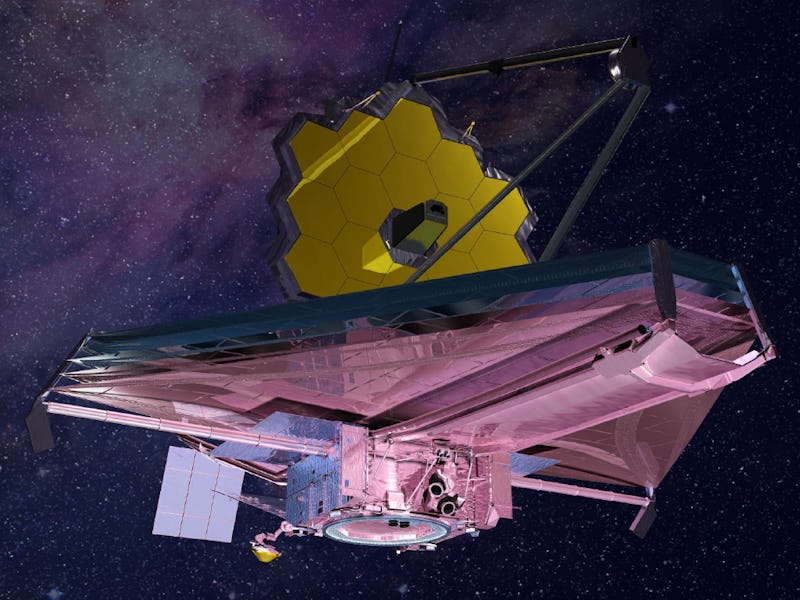Awe-inspiring photo shows the enormous Webb telescope taking a major step toward launch
With a launch finally (supposedly) imminent, every minute counts.

It’s hard to state just how enormous the James Webb Space Telescope is — both as a technological feat and as a physical object. A new photo, released by the European Space Agency, gives an idea of the scope of the ’scope and marks the achievement of one of the final steps toward launch — and toward its 30 days of terror.
The main mirror is 21 feet in diameter or about as tall as a two-story house. Its massive solar shade — needed to enable the spacecraft to peer into the darkness of the void as unencumbered as possible — is nearly the size of a tennis court (78 feet). All of this hardware is designed to exist in space far beyond the reach of crewed repair teams. There, it will unlock the early universe, examine exoplanets in unprecedented detail, and watch galaxies, stars, and planets form.
The telescope has already been folded up for launch, a necessity to get something of this scale into space while still fitting aboard a standard rocket. Now in a new photo, ESA personnel are seen wearing Self-Contained Atmospheric Protective Ensemble suits in the payload preparation facility at ESA’s Spaceport in French Guiana.
These suits are necessary to protect the personnel from highly toxic hydrazine fuel and dinitrogen tetroxide oxidizer. In other words, the photo reveals the fueled James Webb Telescope for the first time.
Almost ready ...
Fueling the Webb took a total of 10 days, according to the agency, and the process was completed on Friday. The telescope is souped up with 79.5 liters of dinitrogen tetroxide oxidizer and 159 liters of hydrazine — the oxidizer enables the hydrazine to burn more efficiently. This fuel is supposed to help the Webb make little adjustments once it is in place at its forever home in space — but first, it has to get there.
What’s next for the James Webb Telescope
The next step is to place the telescope on top of the Ariane 5 rocket that will carry it to a point in space 1 million miles beyond Earth called Lagrangian Point 2. A Lagrangian point is a region of space where a two-body system’s orbital forces can hold a separate third object, like a satellite or, indeed a telescope, in a stable orbit.
The James Webb Telescope will orbit the Sun as if following just behind Earth at this gravitationally stable point. The orbit is necessary for the telescope to perform its best work, but it also puts it out of reach of any servicing mission. This is why everything needs to go just right before Webb leaves the scientists and engineers who have spent decades bringing it to fruition.
After its placed atop the rocket, it will be fitted with a protective faring to help it survive launch. After that, it will go to the Final Assembly building for the last preparations before ESA and NASA take it to its launch pad.
If all goes well, the telescope will leave Earth forever on December 24, 2021, though a previous launch date placed it at December 22. The Ariane rocket will fire for eight minutes to propel the craft to space. The faring will come off once Webb reaches space, and the telescope will then separate from the launch vehicle after a half hour. After two-and-a-half days, the long unfurling process will begin. Then a series of trajectory adjustments will take place during the first week.
In total, it should take six months before the telescope is ready to begin its main science mission.
The mission is a collaboration between NASA, ESA, and the Canadian Space Agency. It is named after former NASA admin James Webb, though the name has attracted controversy due to Webb’s involvement in the “Lavender Scare” of the 1950s and 1960s, which saw LGBT government employees forced out of their jobs because of their sexual orientation.
This article has been updated to reflect a new launch date for the telescope after NASA discovered a technical error.
This article was originally published on